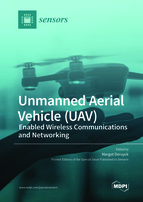Unmanned Aerial Vehicle (UAV)-Enabled Wireless Communications and Networking
A special issue of Sensors (ISSN 1424-8220). This special issue belongs to the section "Communications".
Deadline for manuscript submissions: closed (15 January 2022) | Viewed by 49518
Special Issue Editor
Interests: (green) wireless network design; energy- and exposure-aware networking; 5G and beyond 5G networks; unmanned aerial networks; Internet of Animals; digital agriculture; machine learning
Special Issues, Collections and Topics in MDPI journals
Special Issue Information
Dear Colleagues,
The emerging massive density of human-held and machine-type nodes implies a larger deviation in the traffic than we are facing today. The future network will be characterized by a high degree of flexibility, allowing it to adapt smoothly, autonomously, and efficiently to the quickly changing traffic demand both in time and space. This flexibility cannot be achieved when the network’s infrastructure remains static. To this end, the topic of UAV (unmanned aerial vehicle)-enabled wireless communications and networking has lately been receiving a lot of attention.
As mentioned above, in the future, the network has to serve a massive density of nodes which can be either human-held (user devices) or machine-type nodes (sensors). If we want to properly serve these sensors and get the most out of their data, a proper wireless connection is fundamental. By using UAV-enabled communication and networks, we will able to achieve this.
This Special Issue will address the many open issues that still exist to allow UAV-enabled wireless communications and networking.
Dr. Margot Deruyck
Guest Editor
Manuscript Submission Information
Manuscripts should be submitted online at www.mdpi.com by registering and logging in to this website. Once you are registered, click here to go to the submission form. Manuscripts can be submitted until the deadline. All submissions that pass pre-check are peer-reviewed. Accepted papers will be published continuously in the journal (as soon as accepted) and will be listed together on the special issue website. Research articles, review articles as well as short communications are invited. For planned papers, a title and short abstract (about 100 words) can be sent to the Editorial Office for announcement on this website.
Submitted manuscripts should not have been published previously, nor be under consideration for publication elsewhere (except conference proceedings papers). All manuscripts are thoroughly refereed through a single-blind peer-review process. A guide for authors and other relevant information for submission of manuscripts is available on the Instructions for Authors page. Sensors is an international peer-reviewed open access semimonthly journal published by MDPI.
Please visit the Instructions for Authors page before submitting a manuscript. The Article Processing Charge (APC) for publication in this open access journal is 2600 CHF (Swiss Francs). Submitted papers should be well formatted and use good English. Authors may use MDPI's English editing service prior to publication or during author revisions.
Keywords
- UAV-aided network
- UAV-enabled communication
- drones
- UABS
- 5G
- beyond 5G







